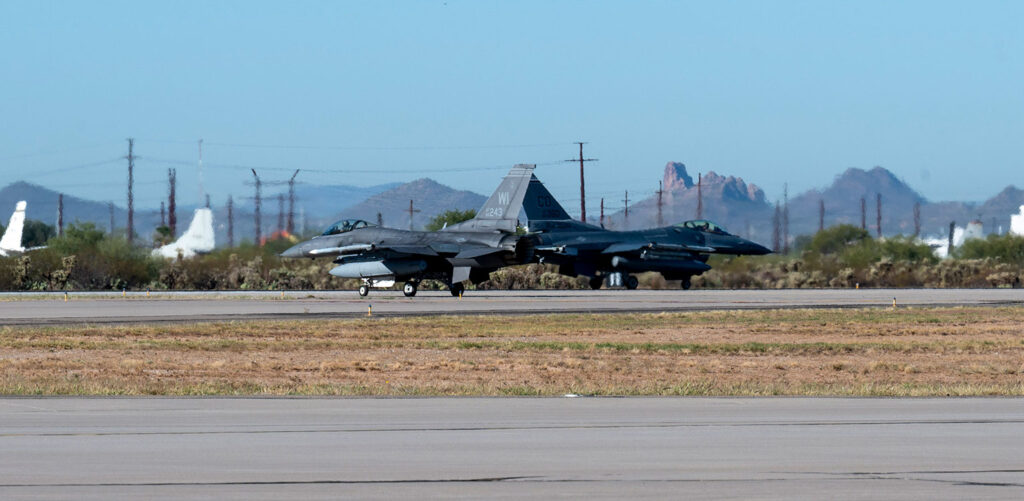North American Aerospace Defense Command F-16 fighter jets prepare to take off to intercept a “track of interest” aircraft as part of Amalgam Eagle 23, a live-fly air defense exercise. MICHAEL DOUGHERTY/U.S. AIR FORCE
THE WATCH STAFF
Seamlessly tracking common aerial threats along the U.S.-Mexican border.
Picture this: A private plane en route from Santa Fe, New Mexico, to Chihuahua, Chihuahua, goes quiet. The pilot fails to respond to repeated communications from air traffic control. U.S. authorities designate the plane a track of interest (TOI) and notify Mexican authorities. Both nations scramble aircraft to intercept the suspicious plane. An F-16 is the first to intercept and determines the pilot is having a medical emergency. A T-6C immediately intercepts the TOI as it passes over the border. The pilot then regains consciousness, and Mexican authorities provide guidance for returning the aircraft to El Paso, Texas.
This was the first of two scenarios enacted in Amalgam Eagle 23, a joint U.S.-Mexico live-fly air defense exercise conducted November 7, 2023. Members of Air Forces Northern (AFNORTH, the designated air sovereignty and air defense component of U.S. Northern Command) participated alongside personnel from the Mexican Air Force (FAM), the Mexican Secretariat of National Defense – National Center for Air Space Surveillance and Protection (SEDENA – CENAVI), Service to Navigation in the Mexican Air Space, and other interagency partners.
The exercise’s objective was to demonstrate and increase operational and communications capabilities between AFNORTH and SEDENA through the detection, identification and transfer of information related to simulated illicit or threatening aerial targets. This supports the Bilateral Military Cooperation Roundtable, the framework between U.S. and Mexico that governs bilateral security cooperation.
“Amalgam Eagle provides an excellent opportunity to exercise live-fly air defense scenarios with our federal Mexican counterparts along the southern border and fosters theater security cooperation (TSC) with the government of Mexico to increase air operational compatibility,” wrote Lt. Col. Julio Sanchez, chief of the Theater Security Cooperation Division, AFNORTH, in an email to The Watch. “The Amalgam Eagle exercise has identified windows of opportunity to improve operational compatibility by establishing current hypothetical scenarios that allow agencies in charge of air surveillance in both countries to develop their capabilities and update coordination procedures.”
This year’s iteration included two scenarios. The first required U.S. and Mexican authorities to track and intercept a pilot experiencing a medical emergency as he flew over the border. This scenario also involved a simulated crash on the Mexico side of the border that initiated further intelligence, surveillance and reconnaissance (ISR) as well as search and rescue (SAR) scenarios for SEDENA-CENAVI to execute — a first for the exercise series.
The second scenario simulated the theft of a private general aviation aircraft in Texas and required U.S. authorities to track, intercept and evaluate the trajectory of the TOI and notify SEDENA-CENAVI, as stipulated by the binational memorandum of understanding between AFNORTH and SEDENA.
Amalgam Eagle 23 demonstrated the interoperability of U.S. and Mexican military forces and both countries’ common interest in a strong and secure border. The operation also allowed AFNORTH to forge closer ties with FAM and SEDENA-CENAVI.
This included the exchange of personnel between Mexico and U.S. command and control centers, with the 601st Air Operations Center at Tyndall Air Force Base, Florida, hosting three officers from Mexico, and SEDENA-CENAVI hosting three U.S. officers. “Going forward, this will allow us to share best practices and procedures between each other’s air management experts,” Lt. Col. Sanchez said.
Both sides were pleased with the outcome of the exercise, noting that all participants achieved the planned learning and exercise objectives, and that the exercise reaffirmed the memorandum of understanding between AFNORTH and SEDENA. “Amalgam Eagle stands as a testament to the enduring partnership between the U.S. and Mexico, and in this exercise, we not only safeguard our shared borders but also strengthen our bonds of cooperation,” said Lt. Gen. Stephen Nordhaus, commander, AFNORTH. “Through shared communication and preparedness, we hone our collective expertise, while fostering innovation and resilience. In the ever-evolving landscape of security, AMALGAM EAGLE propels us forward, ensuring our skies remain sovereign and our nations secure, that we are stronger together and stronger tomorrow.

